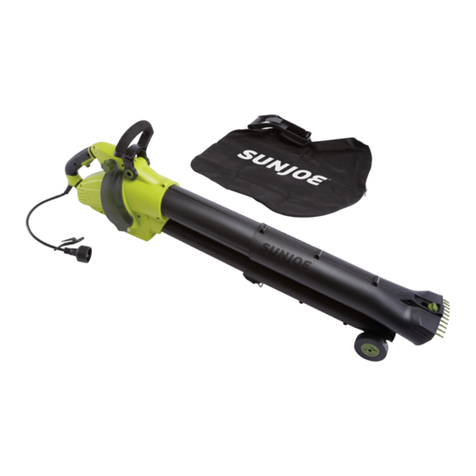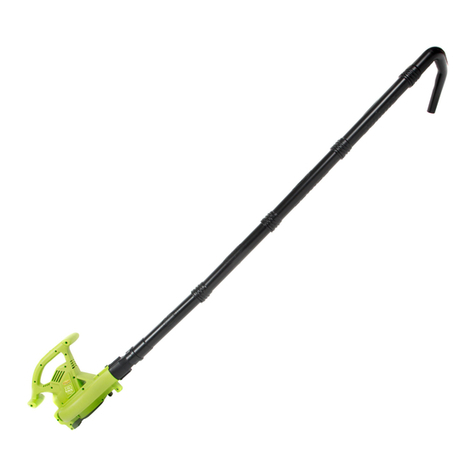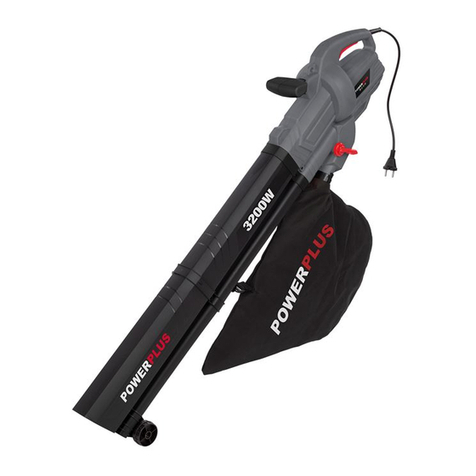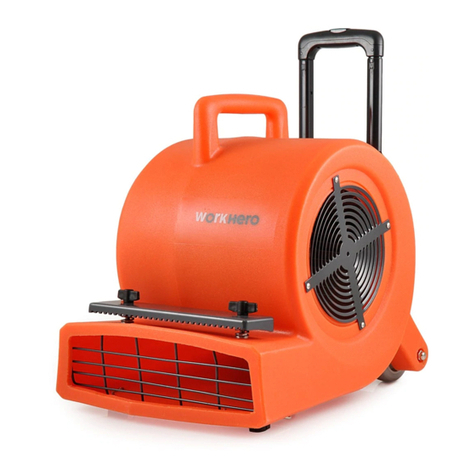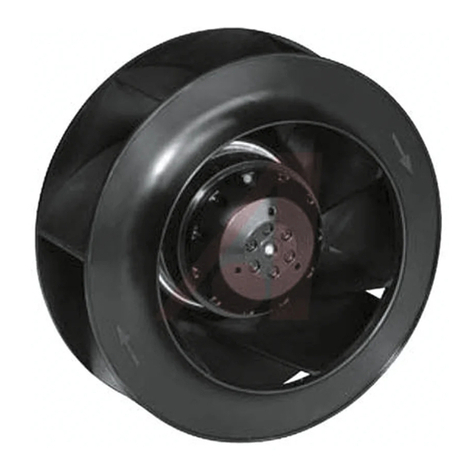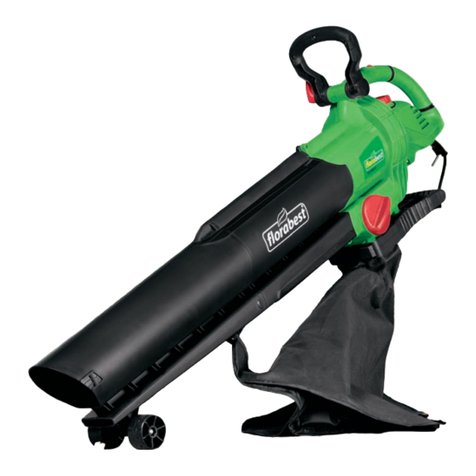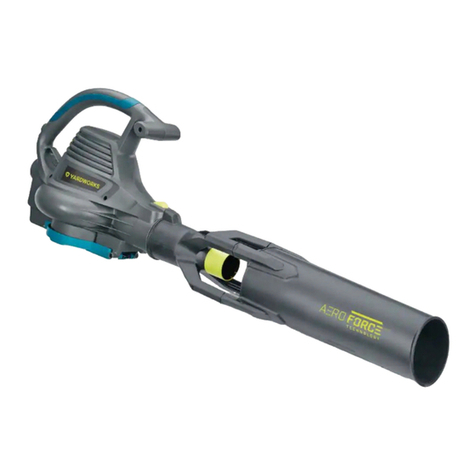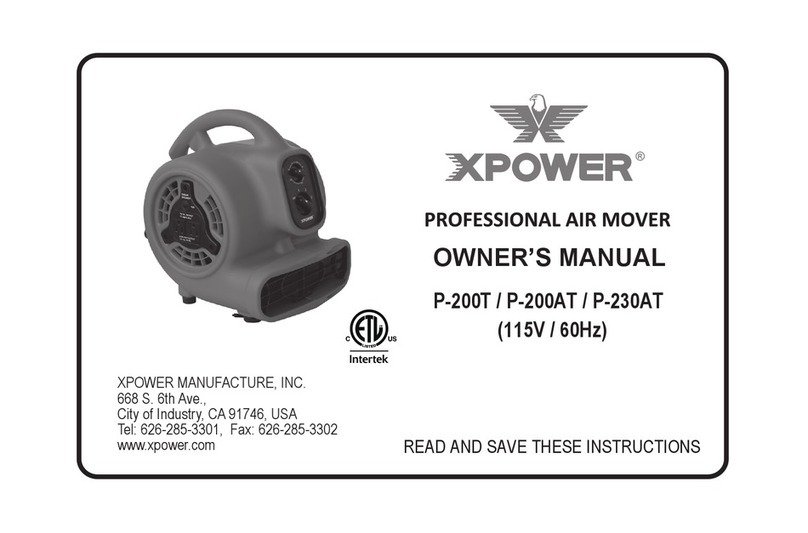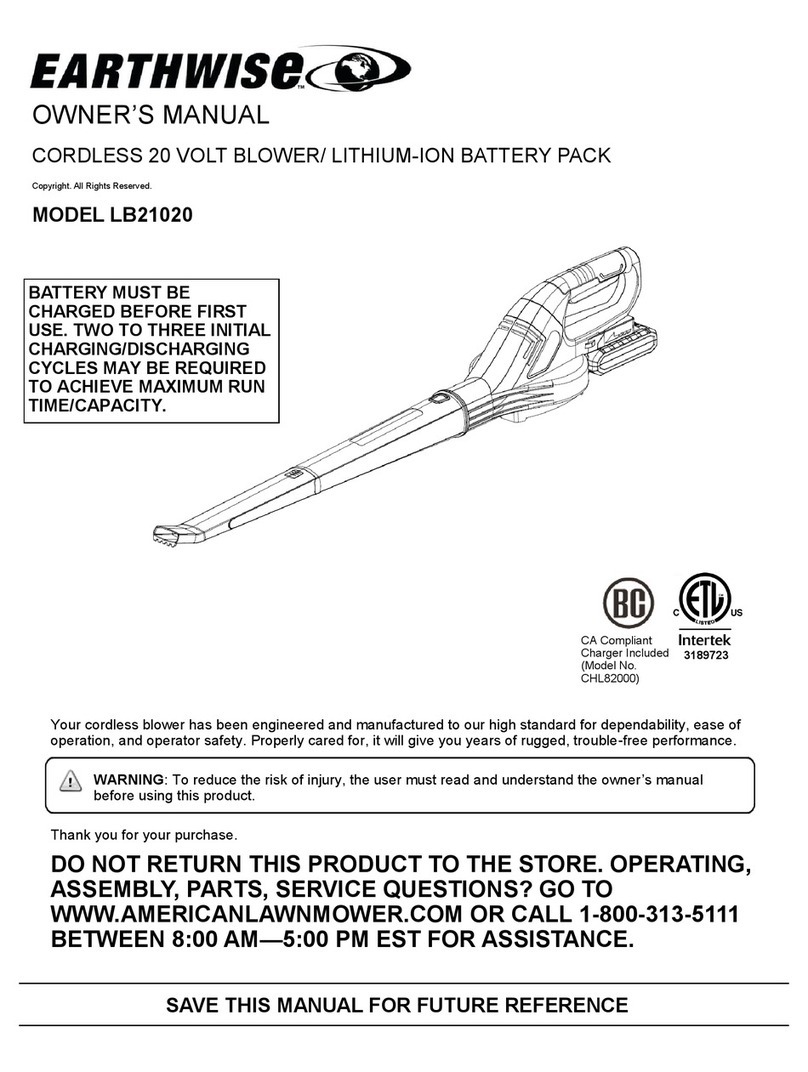VITINNI JK08014301 User manual

40V Battery Operated Cordless Leaf Blower
40V Batteriebetriebener kabelloser Laubbläser
PLEASE READ AND KEEP THESE INSTRUCTIONS FOR FUTURE USE
SAP Code: JK08014301
For further assistance, other products and more, join us at:
Website: www.vitinni.co.uk
Instagram: @vitinniuk
Facebook: www.facebook.com/vitinni

1
Thank you for choosing our Vitinni Battery Operated Cordless Leaf Blower. Please
read this user manual carefully and keep it for future reference. If you need any
assistance, please contact our customer service team on the details provided on the
back page of this manual.
Description of the Symbols
Caution! Read the following instructions carefully to familiarize yourself
with the controls and correct use of the leaf blower. Not using the leaf blower in
accordance with these instructions can cause serious injury. When using electrical
tools, obey the general safety instructions as well as the following safety instructions
in order to reduce the risks of fire, electric shock and injury.
Read the operator’s manual before use.
Conforms to European standards.
These symbols indicate the requirement of wearing eye protection and ear
protection.
Keep hands out of rotation fan.

Do not expose to rain.
Keep bystanders away.
The crossed-out wheeled bin symbol indicates that the item should be disposed of
separately from household waste. The item should be handed in for recycling in
accordance with local environmental regulations for waste disposal. By separating a
marked item from household waste, you will help reduce the volume of waste sent
to incinerators or land-fill and minimize any potential negative impact on human
health and the environment.
2

Safety Warnings
IMPORTANT
READ CAREFULLY BEFORE USE. KEEP FOR FUTURE REFERENCE.
Safe operating practices for hand-held mains-operated electrical garden vacuums,
and garden blower/vacuums with or without shredding means and garden blowers.
1) Training
a) Read the instructions carefully. Be familiar with the controls and the proper use of
the appliance.
b) Never allow children, persons with reduced physical, sensory or mental
capabilities or lack of experience and knowledge or people unfamiliar with these
instructions to use the machine. Local regulations may restrict the age of the
operator.
c) Keep in mind, that the operator or user is responsible for accidents or hazards
occurring to other people or their property.
2) Preparation
a) Wear protection and safety glasses at all times while operating the machine.
b) While operating the machine always wear substantial footwear and long trousers.
Do not operate the machine when barefoot or wearing open sandals. Avoid wearing
clothing that is loose fitting or that has hanging cords or ties.
c) Do not wear loose clothing or jewellery that can be drawn into the air inlet. Keep
long hair away from the air inlets.
d) Operate the machine in a recommended position and only on a firm, level surface.
e) Do not operate the machine on a paved or gravel surface where ejected material
could cause injury.
f) Before use, always visually inspect to check that fasteners are secure, the housing
is undamaged and that guards and screens are in place. Replace worn or damaged
components in sets to preserve balance. Replace damaged or unreadable labels.
g) Never operate the machine while people, especially children, or pets are nearby.
3

3) Operation
a) Keep your face and body away from the blowing opening.
b) Do not allow hands or any other part of the body or clothing inside the blowing
opening, discharge chute, or near any moving part.
c) Keep proper balance and footing at all times. Do not overreach. Never stand at a
higher level than the base of the machine. Always be sure of your footing on
slopes. Walk; never run whilst using the appliance.
d) Always stand clear of the discharge zone when operating this machine.
e) If the machine should start making any unusual noise or vibration, immediately
shut off the power source and allow the machine to stop. Remove the battery and
take the following steps before restarting and operating the machine:
i) inspect for damage;
ii) replace or repair any damaged parts;
iii) check for and tighten any loose parts.
f) Do not allow processed material to build up in the discharge zone; this may
prevent proper discharge and can result in kickback of material through the intake
opening.
g) If the machine becomes clogged, shut-off the power source and disconnect the
machine from supply before cleaning debris.
h) Never operate the machine with defective guards or shields, or without safety
devices, for example the front tube in place.
i) Keep the battery compartment clean of debris and other accumulations to
prevent damage to the power source or possible fire.
j) Do not transport this machine while the power source is running.
k) Always remove the battery:
•Whenever the machine is left by the user.
•Before clearing a blockage.
•Before checking, cleaning or working on the machine.
•After striking a foreign object to inspect the machine for damage.
•If the machine starts to vibrate abnormally, for immediately check.
l) Do not tilt the machine while the power source is running.
4

4) Maintenance and Storage
a) When the machine is stopped for servicing, inspection, or storage, or to change
an accessory remove battery and make sure that all moving parts are come to a
complete stop. Allow the machine to cool before making any inspections,
adjustments, etc. Maintain the machine with care and keep it clean.
b) Store the machine in a dry place out of the reach of children.
c) Always allow the machine to cool before storing.
d) Replace worn or damaged parts for safety. Use only genuine replacement parts
and accessories.
e) Never attempt to override the interlocked feature of the guard.
f) Have your machine by a qualified repair person using only identical replacement
parts. This will ensure that the safety of the machine is maintained.
g) Do not to touch moving hazardous parts before battery is removed and the
moving hazardous parts have come to a complete stop.
5) Battery Tool Use and Care
a) Recharge only with the charger specified by the manufacturer.
b) Use power tools only with specifically designated battery packs.
c) When battery pack is not in use, keep it away from other metal objects, like paper
clips, coins, keys, nails, screws or other small metal objects, that can make a
connection from one terminal to another. Shorting the battery terminals together
may cause burns or a fire.
d) Under abusive conditions, liquid may be ejected from the battery; avoid contact. If
contact accidentally occurs, flush with water. If liquid contacts eyes, additionally
seek medical help. Liquid ejected from the battery may cause irritation or burns.
e) Do not use a battery pack or tool that is damaged or modified. Damaged or
modified batteries may exhibit unpredictable behaviour resulting in fire, explosion or
risk of injury.
5

6
f) Do not expose a battery pack or tool to fire or excessive temperature. Exposure
to fire or temperature above 130 °C may cause explosion.
g) Follow all charging instructions and do not charge the battery pack or tool
outside the temperature range specified in the instructions. Charging improperly or
at temperatures outside the specified range may damage the battery and increase
the risk of fire.
6) Service
a) Have your power tool serviced by a qualified repair person using only identical
replacement parts. This will ensure that the safety of the power tool is maintained.
b) Never service damaged battery packs. Service of battery packs should only be
performed by the manufacturer or authorized service providers.
SAFETY ADVICE FOR RECHARGEABLE BATTERY AND CHARGER
• This appliance can be used by children aged from 8 years and above and
persons with reduced physical, sensory or mental capabilities or lack of experience
and knowledge if they have been given supervision or instruction concerning use of
the appliance in a safe way and understand the hazards involved. Children shall
not play with the appliance. Cleaning and user maintenance shall not be made by
children without supervision.
• For outdoor use only
• Warning! do not recharge non-rechargeable batteries
• Charger only specified for use by the manufacturer should be used to charge the
battery pack for this product.
WARNING! During the use of tools, the basic safety measures must be followed in
order to reduce fire hazards, electrolyte leakage and personal injury, including the
following precautions:
Ensure that the battery pack is suitable for the tool.
Ensure that outside surface of the battery pack is clean and dry before connecting
it to the charger.
Ensure that the batteries are charged using the correct charger recommended by
the manufacturer. Incorrect use can create a risk of electric shock, overheating or
the leaking of corrosive liquid from the battery.

If there is an electrolyte leak, avoid any contact with the skin. In the event of a leak,
wipe with a rag. If the liquid comes into contact with the skin, rinse abundantly with
water. In the event of a reaction or contact with the eyes or mucous membranes,
consult a doctor.
Ensure that the appliance is properly switched off before inserting the battery into
the appliance. Inserting a battery into an appliance while it is switched on can
cause accidents.
Use the appliance only with the type of battery recommended by the manufacturer.
Using another type of battery can create a serious risk of injury and cause a fire.
Disposal of Batteries
Ensure that the battery is properly disposed of:
1-Do not throw it away
2-Do not to burn it
3-Do not throw it in a river
4-Dispose of it in the designated collection containers (ask your retailer)
Intended Use
Your blower is designed to blow the leaves and dust.
It is designed for use in private and hobby gardens. It is regarded as unsuitable for
use in public facilities, parks and sports centers, along roadways, or in agriculture
and forestry. The operating instructions as supplied by the manufacturer must be
kept and referred to in order to ensure that the equipment is properly used and
maintained.
The equipment may be used only for the tasks it is designed to handle. Any other
use is deemed to be a case of misuse. The user/operator and not the manufacturer
will be liable for any damage or injuries of any kind resulting from such misuse.
Please note that our equipment has not been designed for use in commercial or
industrial applications. The warranty will bevoided if the equipment is used in
commercial, trade or industrial businesses or for equivalent purposes.
7

Technical Specifications
Model
BLC40
Rated voltage
40V d.c.
Air speed max. at high speed
48m/s
Air volume max. at high speed
920m3/h
Air speed max. at normal speed
22m/s
Air volume max. at normal speed
450m3/h
Weight
2.3kg (without battery pack)
Sound pressure level: LPA
88 dB(A) K=3 dB(A)
Sound power level: LWA
101dB(A) K=3 dB(A)
Vibration:
ahmax. 4.338 m/s2 K=1.5 m/s2
Suggested battery pack
BT4020SA
Suggested charger
BC4020B (British market)
BC4020G (German market)
Remarks: The blower should exclusively use the battery and charger suggested
above. Other type battery and charger are never allowed
Noise and Vibration Information
Measured sound values determined according to EN 50636-2-100:2014.
The noise figures quoted are emission levels and are not necessarily safe working levels.
Whilst there is a correlation between the emission and exposure levels, this cannot be used
reliably to determine whether or not further precautions are required. Factors that influence
the actual level of exposure of work-force include the characteristics of the work room, the
other sources of noise, etc. i.e. the number of machines and other adjacent processes, and
the length of timefor which an operator is exposed to the noise. Also the permissible
exposure level can vary from country. This information, however, will enable the user of the
machine to make a better evaluation of the hazard and risk.
Wear hearing protection!
Vibration total values (triax vector sum) determined according to EN 50636-2-100:2014.
The vibration emission level given in this information sheet has been measured in
accordance with a standardized test given in EN 50636-2-100:2014 and may be used to
compare one tool with another.
It may be used for a preliminary assessment of exposure.
The declared vibration emission level represents the main applications of the tool. However if
the tool is used for different applications, with different accessories or poorly maintained, the
vibration emission may differ. This may significantly increase the exposure level over the
total working period.
An estimation of the level of exposure to vibration should also take into account the times
when the tool is switched off or when it is running but not actually doing the job. This may
significantly reduce the exposure level over the total working period.
Identify additional safety measures to protect the operator from the effects of vibration such
as: maintain the tool and the accessories, keep the hands warm, organization of work
patterns.
8

List of Main Parts
Charging process
NOTE: Batteries (not suppled) are not fully charged on delivery. Before first use,
fully charge the batteries.
Chargers (not supplied) are only suitable to charge the battery pack- BT4020. Do
not use the charger for any other battery pack.
Do not use this product in any other way as stated for normal use. Not observing
general regulations and instructions from this manual does not make the
manufacturer liable for damages.
CAUTION! Use only recommended batteries with the battery charger.
9

10
1. Put the battery into the slot of charger,Make sure the battery and charger is
fully connected.(Fig.1)
2. Insert the plug to mains. The LED flashes green and the battery is charging.
When the battery is fully charged, the LED lights green. (Fig.2)
3. To remove, press the release button and pull out the battery pack. (Fig.3)
4. Pull out the mains plug.
Charging indicator
The battery pack is equipped with 4 LED lights that will display the current battery
level by pressing battery indicator button (a).

11
Battery capacity display
4 green LED lights are constantly burning between 75% -100%.
3 green LED lights are constantly burning between 50% -75%.
2 green LED lights constantly burns between 25% -50%
1 green LED lights constantly burning lower than 25%
If no LED lights come on, even after pressing the indicator button, the battery is
defective and needs to be replaced.
For safety reasons, the capacity of the battery can only be checked when the
machine has come to a complete stop.
NOTE: Batteries may become warm while charging. This is normal. If the battery
is hot after continuous use in the tool, allow it to cool down to room temperature
before charging. This will extend the life of your batteries.
WARNING: Always disconnect the battery pack from the tool before any
assembly, adjustments or changing accessories.
Warning: The leaf blower must not be used or switched on until it has been fully
assembled.
Assembly of Machine
The leaf blower is supplied with some components not assembled. To assemble
these proceed as follows:
Connect Blower Tube
Align the hole (a) on blower tube with the button (b) on motor unit, insert the blower
tube on the machine.
11

12
Fitting and Removing the Battery Pack (Not Included)
To insert the battery pack, place it on the guide track and push it into the housing. It
will audibly snap in.
To remove the battery pack, press the release button (a) and pull it out.
Operation
Warning: Before use, assure all parts are assembled completed and properly, if
the switch ON/FF function doesn’t work, contact your dealer immediately.
Note: the blower has two speeds. Never use the high speed with too long time,
long time use at high speed would shorten the durability of the blower.
• To switch on, press and hold the On/Off switch (3), device would function at
normal speed.
• To switch off, let go of the On/Off switch.
• For high speed/max. airflow, press and hold the turbo button (2)
ATTENTION: Only use the turbo button (2) with heavy accumulations (higher
battery consumption and therefore shorter run time of the leaf blower when the
turbo button is pressed)
• To reduce the airflow again, release the turbo button (2)
• Channel the air stream forward and walk slowly to blow foliage or garden refuse.

13
Maintenance and Storing
CAUTION: Before putting away or cleaning, switch off and remove the battery
pack.
Maintenance
• Regular cleaning and maintenance of your blower will ensure efficiency and
prolong the life of your machine. During operation, keep the air slots clean and free
of debris.
• Damaged parts must be repaired or replaced by an authorized service department
before you can work with the device
• Use only the manufacturer’s recommended replacement parts and accessories.
Using other components can lead to fire
• Use the device only with batteries as reccomended by the manufacturer.
• Do not use the charger if it is damaged.
• Keep all safety devices, air vents and the motor housing free of dirt and dust as
far as possible. Wipe the equipment with a clean cloth or blow it down with
compressed air at low pressure.
• We recommend that you clean the equipment immediately after you use it.
• Clean the equipment regularly with a damp cloth and soap. Do not use cleaning
agents or solvents; these may be aggressive to the plastic parts in the equipment.
Ensure that no water can get into the interior of the equipment. The ingress of water
into an electric tool increases the risk of an electric shock.
• Use a brush to remove deposits from the safety guard.
• When not in use, store the machine out of the reach of children
•Have your power tools serviced by a qualified repair person using only identical
replacement parts. This will ensure that the safety of the power tool is maintained

Storage
• Store the device in a dry and frost-free place.
• Store the battery and the device separately from each other.
• Charge the battery before storing it for the winter.
• Keep the device, and its plastic components in particular, always from brake fluid,
petrol, products containing oil, penetrating oil etc. They contain chemical
substances that may damage or destroy the plastic parts of the device.
• Fertilizers and other garden chemicals contain substances which can have a
heavily corrosive effect on metal parts. Do not store the device close to these
substances.
Troubleshooting
14

Customer Services:
If you would like further advice or information on your product, ensure you have the
SAP code ready and please get in touch with us at Vitinni on the contact options
below:
SAP Code: JK08014301
Phone: 0330 002 1600 (Mon –Fri 9am to 5pm)
Email: support@vitinni.co.uk
Address: Vitinni, Vale Mill (Rochdale) Ltd, Robinson Street, Rochdale, OL16 1TA
Guarantee
Our products are guaranteed for a period of 2 years from the date of purchase. Products that
develop a fault within this period are covered by our warranty and we will replace defective
parts, or where not available the whole product. The warranty does not apply to any defect in
the goods arising from fair wear and tear, wilful damage, accident, negligence by you or any
third party, use otherwise than as recommended by us, failure to follow our instructions, any
alteration or repair carried out without our approval or has been the subject of commercial use.
Your statutory rights remain unaffected, in particular any rights you have under the Consumer
Rights Act 2015.
If you have a problem with your product within this warranty period please contact our
customer services team.
In the event of changes to the specification of a product and we are not able to replace parts,
we will replace the whole product within the 2 year guarantee period
For products that fall outside of the 2 year guarantee, we will endeavour to provide spare parts
to purchase for as many of the replaceable parts as possible, but cannot foresee specification
changes or upgrades to products or parts outside of the initial 2 year period.
15

16
Vielen Dank, dass Sie sich für unseren batteriebetriebenen, kabellosen Laubbläser von
Alfresia entschieden haben. Bitte lesen Sie diese Bedienungsanleitung sorgfältig durch und
bewahren Sie diese zum späteren Nachschlagen auf. Wenn Sie Hilfe benötigen, wenden Sie
sich bitte an unseren Kundendienst. Die Einzelheiten finden Sie auf der Rückseite dieses
Handbuchs.
Beschreibung der Symbole
Vorsicht! Lesen Sie die folgenden Anweisungen sorgfältig durch, um sich mit den
Bedienelementen und der korrekten Verwendung des Laubbläsers vertraut zu machen. Wird
der Laubbläser nicht gemäß diesen Anweisungen verwendet, kann dies zu schweren
Verletzungen führen. Beachten Sie bei der Verwendung von Elektrowerkzeugen die
allgemeinen Sicherheitshinweise, sowie die folgenden Sicherheitshinweise, um die Gefahr von
Feuer, Stromschlag und Verletzungen zu verringern.
Lesen Sie vor dem Gebrauch die Bedienungsanleitung.
Entspricht den europäischen Normen.
Diese Symbole weisen auf die Anforderung hin, Augenschutz und Gehörschutz zu tragen.
Halten Sie die Hände vom Gebläse fern.

17
Nicht dem Regen aussetzen.
Halten Sie umstehende Personen fern.
Das Symbol des durchgestrichenen Abfalleimers weist darauf hin, dass der Artikel
getrennt vom Hausmüll entsorgt werden muss. Das Produkt sollte zur
Wiederverwertung gemäß den örtlichen Umweltschutzbestimmungen für die
Abfallentsorgung abgegeben werden. Indem Sie einen gekennzeichneten
Gegenstand vom Hausmüll trennen, reduzieren Sie die Menge der Abfälle, die in
Verbrennungsanlagen oder auf Deponien entsorgt werden und minimierenmögliche
negative Auswirkungen auf die menschliche Gesundheit und die Umwelt.

18
Sicherheitswarnungen
WICHTIG
VOR GEBRAUCH SORGFÄLTIG DURCHLESEN. FÜR ZUKÜNFTIGE VERWEISE
AUFBEWAHREN.
Sichere Betriebspraktiken für handgehaltene netzbetriebene elektrische
Gartenbeläse / Laubgebläse mit oder ohne Zerkleinerungsmittel.
1) Übung
a) Lesen Sie die Anweisungen sorgfältig durch. Machen Sie sich mit den
Bedienelementen und dem richtigen Gebrauch des Geräts vertraut.
b) Erlauben Sie niemals Kindern, Personen mit eingeschränkten körperlichen,
sensorischen oder geistigen Fähigkeiten oder mangelnder Erfahrung und Kenntnis
oder Personen, die mit diesen Anweisungen nicht vertraut sind, das Gerät zu
benutzen. Örtliche Vorschriften können das Alter des Bedieners einschränken.
c) Beachten Sie, dass der Bediener oder Benutzer für Unfälle oder Gefahren
verantwortlich ist, die für andere Personen oder deren Eigentum eintreten.
2) Vorbereitung
a) Tragen Sie während des Betriebs der Maschine stets eine Schutzkleidung und
eine Schutzbrille.
b) Tragen Sie während des Betriebs des Geräts immer festes Schuhwerk und eine
lange Hose. Betreiben Sie das Gerät nicht barfuß oder mit offenen Schuhen.
Vermeiden Sie es, locker sitzende Kleidung oder Kleidung mit hängenden Schnüren
oder Bindungen zu tragen.
c) Tragen Sie keine weite Kleidung oder Schmuck, die in den Luftschlitzen gezogen
werden könnten. Halten Sie lange Haare von den Luftschlitzen fern.
d) Betreiben Sie die Maschine nur auf festem, ebenem Untergrund.
e) Betreiben Sie die Maschine nicht auf gepflasterten oder Kiesflächen, auf denen
umhergeschleudertes Material Verletzungen verursachen kann.
f) Überprüfen Sie vor dem Gebrauch immer visuell, ob die Befestigungselemente fest
sitzen, das Gehäuse unbeschädigt ist und ob Schutzvorrichtungen und
Abschirmungen vorhanden sind. Ersetzen Sie verschlissene oder beschädigte
Komponenten und Etiketten.
g) Betreiben Sie das Gerät niemals, wenn sich Personen, insbesondere Kinder oder
Haustiere in der Nähe befinden.

19
3) Betrieb
a) Halten Sie Gesicht und Körper von der Blasöffnung frei.
b) Lassen Sie keine Hände oder andere Körperteile oder Kleidungsstücke in die
Blasöffnung, den Auswurfschacht oder in die Nähe eines beweglichen Teils
gelangen.
c) Achten Sie stets auf Gleichgewicht und einen sicheren Stand. Übergreifen Sie
nicht. Stellen Sie sich niemals auf eine höhere Ebene als die Basis des Geräts.
Achten Sie beim Befahren von Hängen immer auf sicheren Stand. Während des
Gebrauchs des Geräts darf nur gegangen und nicht gelaufen werden.
d) Halten Sie sich beim Betrieb dieses Geräts immer von der Entladezone fern.
e) Sollte die Maschine ungewöhnliche Geräusche oder Vibrationen verursachen,
schalten Sie sofort die Stromquelle aus und lassen Sie das Gerät anhalten.
Entfernen Sie den Akku und führen Sie die folgenden Schritte aus, bevor Sie das
Gerät neu starten und in Betrieb nehmen:
iv) Auf Beschädigungen untersuchen;
v) Beschädigte Teile ersetzen oder reparieren;
vi) Auf lose Teile prüfen und diese festziehen.
f) Lassen Sie nicht zu, dass sich verarbeitetes Material in der Entladezone
ansammelt. Dies kann eine ordnungsgemäße Abgabe verhindern und zu einem
Rückschlag von Material durch die Einlassöffnung führen.
g) Wenn die Maschine verstopft ist, schalten Sie die Stromquelle aus und trennen
Sie die Maschine von der Stromversorgung, bevor Sie Ablagerungen entfernen.
h) Betreiben Sie die Maschine niemals mit defekten Schutzvorrichtungen oder
Schutzschildern oder ohne Sicherheitsvorrichtungen, z.B. wenn das vordere Rohr
angebracht ist.
i) Halten Sie das Batteriefach frei von Schmutz und anderen Ansammlungen, um
Schäden an der Stromquelle oder einen möglichen Brand zu vermeiden.
j) Transportieren Sie dieses Gerät nicht, während die Stromquelle läuft.
k) Nehmen Sie immer den Akku heraus:
•Wann immer das Gerät vom Benutzer verlassen wird.
•Vor dem Beseitigen einer Blockade.
•Vor dem Überprüfen, Reinigen oder anderen Arbeiten an dem Gerät.
•Wenn das Gerät auf Beschädigungen untersucht wird.
•Wenn die Maschine ungewöhnlich zu vibrieren beginnt.
l) Kippen Sie die Maschien nicht, während die Stromquelle läuft.
Table of contents
Languages:
Popular Blower manuals by other brands

M.K.Plastics
M.K.Plastics PRVS Installation, operation and maintenance manual

VALERII S & M GROUP
VALERII S & M GROUP PREMIUM-HD 0503JSCB15A Original instruction manual

Pro Work
Pro Work PG-EL 2150 operating instructions
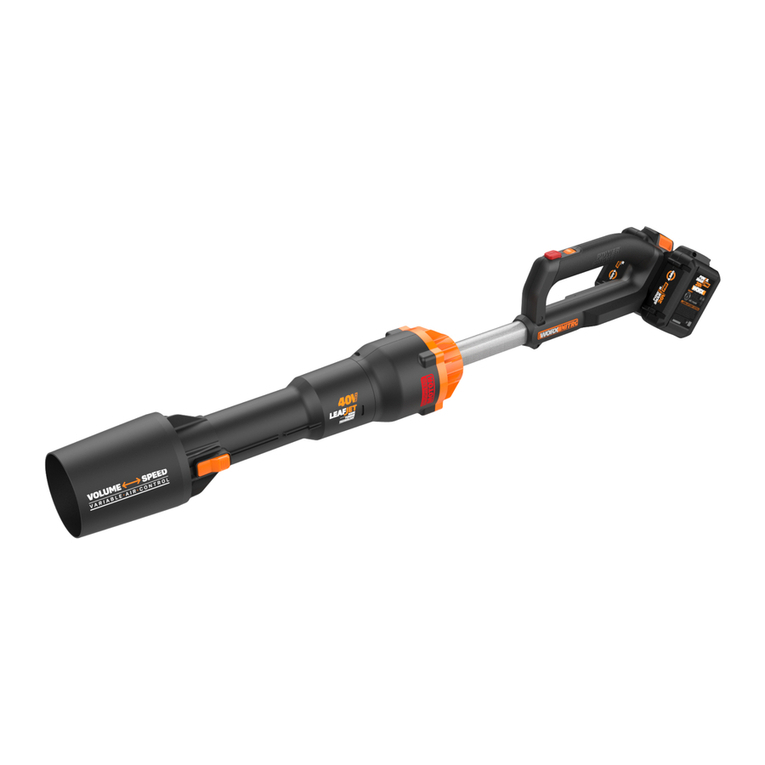
Worx Nitro
Worx Nitro LEAFJET WG585 manual
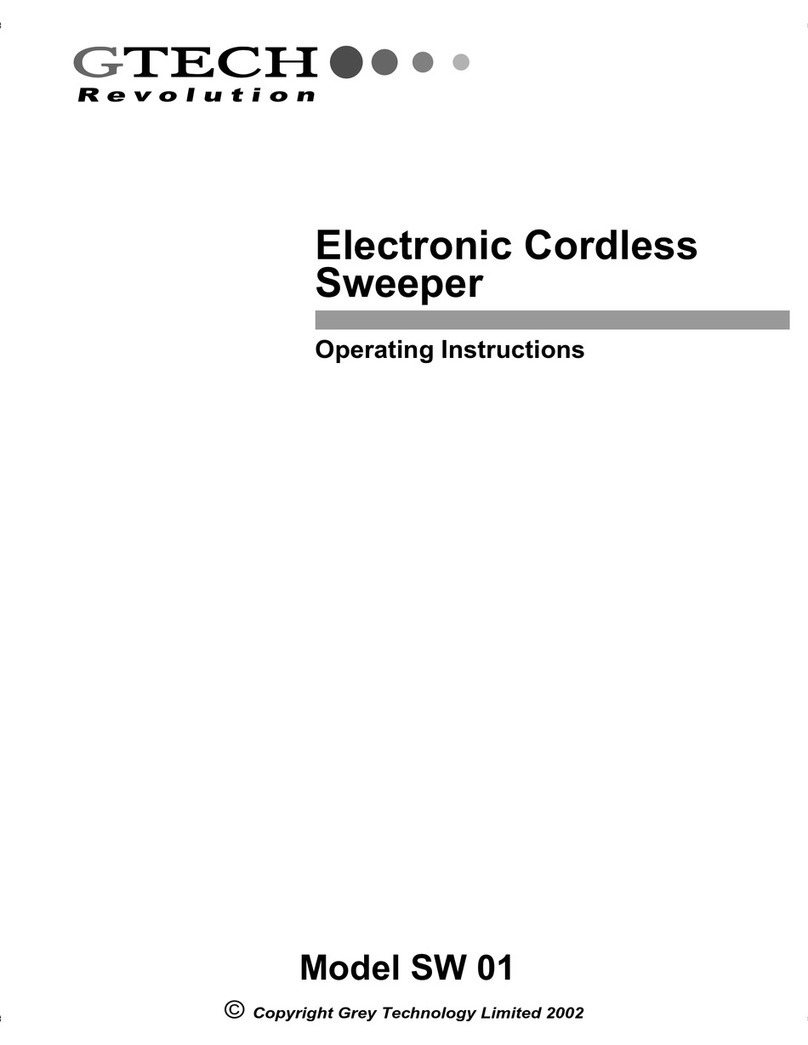
Gtech
Gtech SW 01 operating instructions

FLORABEST
FLORABEST FLS 3000 B2 Translation of the original instructions
